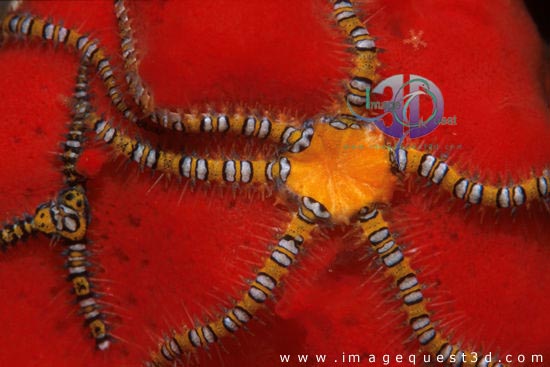|
Orange-banded Brittle Star (Ophiothrix) ©
2000 by Image Quest 3-D
Read our copyright notice
Photograph by Roger Steene Brittle Stars are members of the Phylum Echinodermata. All adult echinoderms have a number of shared characteristics. They display pentagonal radial symmetry, possess an internal skeleton of calcium carbonate plates (ossicles) and have a unique water vascular system comprising a series of radiating canals that terminate in tube feet. Tube feet penetrate the body wall and often possess a tiny suction cup at the terminal end. The body fluid, with an ionic compostion very close to the surrounding water, circulates through this system, allowing for hydraulic expansion and contraction of the tube feet that are used for a variety of functions such as locomotion, feeding and respiration. Echinoderms are exclusively marine creatures with a wide geographical distribution, inhabiting the sea floor from the intertidal zones to the deep sea. The group has a long history, stretching back over 500 million years, however the living representatives are organised into at least five classes: the Crinoidea (feather stars and sea lilies), the Asteroidea (starfish), the Echinoidea (sea urchins), the Holothuroidea (sea cucumbers) and the Ophiuroidea (brittle stars) (see above). Brittle stars, in general, have five arms attached to a discrete central disk. In many species the arms are easily detached, hence the common name. Most species are selective detritus feeders or predators of small organisms, although some are suspension feeders, capturing small organisms with the tube feet on their upraised arms. Most brittle stars are cryptic, taking shelter in rock crevices during the day and only emerging under the cover of night. They are often found in association with other animals, living in large numbers in the cavities of sponges or crawling on the branches of sessile coelenterates. In turn they are often parasitized by various Protozoa, Polychaeta and Gastropoda. Click here to view the 'Picture of the Week' archive.
|
||||||||
|
|
||||||||


